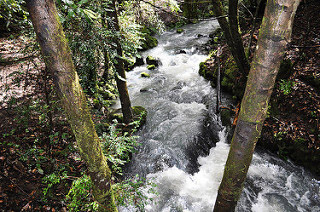Science and Nature
GEOLOGY
Montgomery Woods lies in an area formed during the Cretaceous period, more than 66 million years ago. Two components make up the rocks and soils underlying the woods—a granitic-metamorphic complex and marine deposits of sandstone, shale, and chert—known as the Franciscan Formation.
PLANTS
About half of this reserve’s habitats encompass the mature redwood forest and a mixed conifer forest (Douglas-fir and redwood). Oak woodlands include tanoak, black oak, canyon live oak, and a rare stand of Oregon white oak. Forest understory plants include huckleberries and redwood sorrel, as well as such ferns as sword, goldback, and chain ferns. The reserve also includes more than 500 acres of grasslands with both introduced and native species, including 300 acres of native California oatgrass.
Montgomery Woods has several trees more than 350 feet tall. Such heights are rare this far south in the redwood range. However, conditions here are just right, partly due to rich soil deposited by floodwaters from the small stream that flows through the grove.

Unlike most trees, redwoods thrive in a floodplain environment. While floodwaters and thick deposits of soil kill competing vegetation like Douglas-fir, grand fir, and western hemlock, redwoods endure. Following a flood, a new redwood root system grows rapidly into the new silt deposit.
ANIMALS
The South Fork Big River, which runs through the reserve along Orr Springs Road, supports spawning steelhead and Coho salmon.DNA from their guano confirms that four species of bats—the big brown, long-legged, California myotis, and western small-footed myotis—roost in goose pens (tree cavities) in the reserve.
Other inhabitants include amphibians, including the foothill yellow-legged frog, rough-skinned newt, California slender salamander, coast-range California newt, and red-bellied newt. However, these amphibians blend into their surroundings. By day, most reside under rocks, hollow logs, or beneath the bark of downed trees. Others live in the deep layer of duff on the forest floor, which may be up to a foot thick. The wet months from October to April are migration season, offering your best chance to see an amphibian slowly making its way across the forest floor.
FIRE
Coast redwoods have adapted to withstand fire over millennia. Their great height and thick bark, devoid of flammable resin, help them resist flames. Burls, dormant buds that often form at redwoods’ bases, will sprout new growth after a tree burns. A June 2008 lightning strike at Montgomery Woods resulted in the 3,750-acre Orr Complex fire, which burned about one third of the reserve.
This low-intensity fire scorched the tanoaks and huckleberries. A blanket of ferns disappeared. A fine layer of white ash covered the ground. Yet within six months, ferns again covered the forest floor. Five years later, much of the understory vegetation had grown back. While some trees had fallen or had blackened trunks, most were still standing. The park’s once-burned areas now attest to the restorative powers of fire.
CLIMATE CHANGE
In a time of climate change, redwoods are an asset. Their size and longevity help them store more climate-altering carbon dioxide than other plants. Even old redwoods continue to grow, each year adding more carbon-filled wood than smaller, younger trees. After redwoods die, their rot-resistant wood keeps that carbon out of the atmosphere for a long time.
Could redwoods be harmed by climate change? Many don’t seem to be suffering so far; however, scientists say that increasing temperatures, along with decreasing summer fog, could pose a threat in the decades to come. To find out more about the effects of climate change in California’s redwood parks, go to this Save the Redwoods League web page.
RESEARCH IN THE PARK
With the help of Save the Redwoods League and other funding partners, Montgomery Woods State Natural Reserve has become a living laboratory. It’s one of seven California state parks involved in the Redwoods and Climate Change Initiative launched in 2011 by Save the Redwoods League in partnership with researchers from UC Berkeley, Humboldt State University, and NatureServe.
Montgomery Woods and nine other redwood parks along the California coast also host a Fern Watch project. Sword ferns (Polystichum munitum) show signs of stress sooner than many other plants in the redwood forest. Therefore, measuring a sword fern’s height and abundance over time is a good way of detecting the early signs of climate change. Park visitors can help by taking photos. Find out more on Save the Redwoods League’s website.
